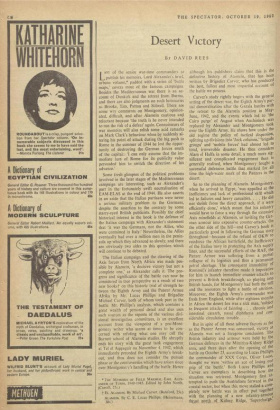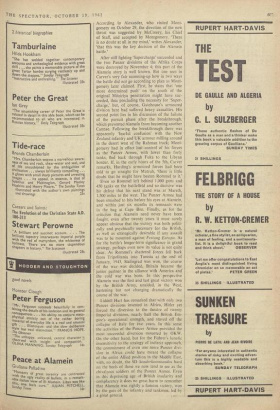Desert Victory
BY DAVID REES AS1 of the senior war-time commanders to 1_, publish his memoirs, Lord Alexander's brief. urbane volume,* padded with a series of 'battle maps,' covers most of the famous campaigns. Besides the Mediterranean war there is an ac- count of Dunkirk and the retreat from Burma, and there are also judgments on such luminaries a, Brooke, Tito, Patton and Stilwell. There are some wry comments on Montgomery, opinion- ated, difficult, and after Alamein cautious and reluctant because 'the truth is he never intended to run the risk of a defeat' again. Connoisseurs of war memoirs will also relish some acid remarks on Mark Clark's behaviour when by suddenly al- tering his point of attack during the big push to Rome in the summer of 1944 he lost the oppor- tunity of destroying the German forces south of the capital: 'I can only assume that the im- mediate lure of Rome for its publicity value persuaded him to switch the direction of his advance.'
Some fresh glimpses of the political problems involved in the later stages of the Mediterranean campaign are interesting, such as Alexander's part in the fortunately swift neutralisation of EAM-ELAS at the end of 1944. He also asserts in an aside that the Italian partisans were never a serious military problem to the Germans, despite the assertion to the contrary by some starry-eyed British publicists. Possibly the chief historical interest in the book is the defence of the Italian campaign with Alexander's statement that 'it was the Germans, not the Allies, who were contained in Italy.' Nevertheless, the Allies eventually had over a million men in the penin- sula up which they advanced so slowly, and there are obviously two sides to this question which will continue to be debated.
The Italian campaign and the clearing of the Axis forces from North Africa was made pos- sible by Alamein, 'a decisive victory but not a complete one,' as Alexander calls it. The pro- gress and significance of the battle can now be considered in true perspective as a result of two new bookst on this historic trial of strength be- tween the Eighth Army and the Panzer Armee Afrika by Mr. Lucas Phillips and Brigadier Michael Carver, both of whom took part in the battle. Mr. Phillips's analysis, which contains a great wealth of personal detail and also uses such sources as the reports of the various divi- sional investigation committees, is an excellent account from the viewpoint of a pro-Mont- gomery writer who seems at times to be con- cerned with refuting what one may call the Barnett school of Alamein studies. He abruptly ends his story with the great tank engagement at Tel el Aqqaquir on November 4, 1942, which- immediately preceded the Eighth Army's break- out, and thus does not consider the pursuit phase or the controversies which have arisen since over Montgomery's handling of the battle. Hence * THE MEMOIRS OF FIELD MARSHAL EARL ALEX- ANDER OF TUNIS, 1940-1945. Edited by John North. (Cassell, 25s.) t EL ALAMEIN. By Michael Carver. (Batsford, 25s.) ALAMEIN. By-C. E. Lucas Phillips. (Heinemann, 30s.)
although his publishers claim that this is the definitive history of Atanicin, that has been written by Brigadier Carver, who has produced the hest, fullest and most impartial account of the battle we possess.
Carver's study rightly begins with the general setting of the desert war, the Eighth Army's par-
tial demoralisation after the Gazala battles with the retreat to the Alamein position in May- June, 1942, and the events which led to 'the Cairo purge' of August when Auchinleck was replaced by Alexander and Montgomery took over the Eighth Army. He shows how under the old regime the policy of tactical dispersion, splitting up divisions into 'Jock columns,"brigade groups' and 'mobile forces' had almost led to total, irreversible disaster. He then considers Alam el Halfa in some detail, a much more sig- nificant and complicated engagement than 15 generally realised, when Montgomery fought a successful defensive battle that marked for all time the high-water mark of the Panzers in the desert.
So to the planning of Alamein. Montgomery, when he arrived in Egypt, 'was appalled at the inefficiency and lack of professional skill which led to failures and heavy casualties. . . . He did not shrink from the direct approach, if it were efficiently done,' which meant that his infantry would have to force a way through the extensive Axis minefields at Alamein, so inviting the Ger- man armour into expensive counter-attacks. On the other side of the hill--and Carver's book Is particularly good in following the German story throughoutbecause of the refusal of OKW to reinforce the African battlefield, the inefficiency of the Italian navy in protecting the Axis supply lines, and the successful efforts of the RAF, the Panzer Armee was suffering from a partial collapse of its logistics and thus a permanent petrol shortage. The consequent immobility of Rommel's infantry therefore made it imperative for him to launch immediate counter-attacks to prevent a British breakthrough, so playing into British hands, for Montgomery had both the will and the resources to fight a battle of attrition. Moreover, the Eighth Army's commander was fresh from England, while after eighteen months in Africa the desert fox was a sick man, 'subject to frequent attacks of fainting . . . chronic and intestinal catarrh, nasal diphtheria and con- siderable circulation trouble. . .
But in spite of all these adverse factors as far as the Panzer Armee was concerned, victory at Alamein was not a foregone conclusion. The British infantry and armour were held by the German defences in the Miteiriya-Kidney Ridge area, and three days after the opening of the battle on October 23, according to Lucas Phillips, the commander of XXX Corps, Oliver Leese, thought we were 'within an ace of losing our grip of the battle.' Both Lucas Phillips and Carver are exemplary in describing how the situation was retrieved. Montgomery first at- tempted to push the Australians forward in the coastal sector, but when this move stalled a coo' pletely new battle was in effect put together with the planning of a new infantry-armour, thrust north of Kidney Ridge, 'Supercharge. According to Alexander, who visited Mont- gomery on October 29, the direction of the new thrust was suggested by McCreery, his Chief of Staff, and accepted by Montgomery. 'There is no doubt at all in my mind,' writes Alexander, `that this was the key decision of the Alamein battle.'
After stiff fighting 'Supercharge' succeeded and the two Panzer divisions of the Afrika Corps were destroyed by November 4; this part of the Alamein story is well known. But one sees in Carver's very fair summing-up how in two ways the battle did not go according to plan as Mont- gomery later claimed. First, he states that 'one more determined push' on the south of the original Miteiriya penetration might have suc- ceeded, thus precluding the necessity for 'Super- charge,' but, of course, Gatehouse's armoured division here had suffered heavy casualties. His second point lies in his discussion of the failure of the pursuit phase after the breakthrough, which prevented Alamein from becoming another Cannae. Following the breakthrough there was apparently `fearful confusion' with the New Zealand infantry and UK armour milling around in the desert west of the Rahman track; Mont- gomery had in effect lost control of his forces as the Panzer Armee, with fewer than forty tanks, fled back through Fuka to the Libyan border. If, in the early hours of the 5th, Carver remarks, Harding's armoured forces had been told to go straight for Matruh, 'there is little doubt that he might have beaten Rommel to it.'
Even so Rommel left behind 1,000 guns and 450 tanks on the battlefield and so decisive was hit: defeat that his next stand was at Mareth, 1,500 miles to the west. The Panzer Armee had been smashed to bits before his eyes at Alamein, and within just six months its remnants were in the bag at Cape Bon. Finally, as for the criticism that Alamein need never have been fought, even after twenty years it must surely appear obvious that the victory was both politi- cally and psychically necessary for the British, as well as strategically desirable if any assault was to be mounted against Festung Europa. As for the battle's longer-term significance in grand strategy, perhaps even now its value is not quite clear. As Rommel's shattered forces fell back from Tripolitania into Tunisia at the end of January, 1943, Stalingrad was won, the course of the war, was decided, Britain became the junior partner in the alliance with America and the cold war was born. In this perspective Alamein was the first and last great victory won by the British Army, unaided, in the West, hastening but not changing dramatically the course of the war.
Liddell Hart has remarked that with only two Panzer divisions invested in Africa, Hitler yet forced the diversion to the theatre of twenty Imperial divisions, nearly half the British Em- pire's operational strength, and staved off the collapse of Italy for two years. In this sense the activities of the Panzer Armee provided the most successful diversion mounted by OKW. On the other hand, but for the Fiihrer's lunatic insensitivity to the strategy of indirect approach, the commitment of even one more Panzer divi- sion in Africa could have meant the collapse of the entire Allied position in the Middle East, with, no doubt, the SD Sonderkommandos hard on the heels of those we now tend to see as the chivalrous soldiers of the Panzer Armee. Even in this depressing age of British insularity and complacency it does no great harm to remember that Alamein was rightly- a famous victory, won by the guts of the infantry and tankmen, led by a great general.















































 Previous page
Previous page